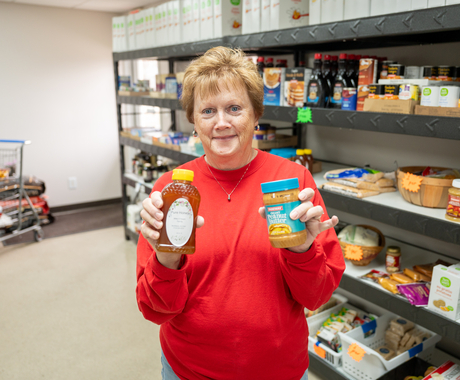As a home gardener, lover of fresh produce, and frequent visitor of farmers markets, Kathy Dirks found it strange that there wasn’t a market in her area. She couldn’t get the idea out of her head that Harrison County, Iowa, needed one and would benefit from it.
After consulting with the director of the Harrison County Conservation Board, where she works, Kathy contacted the chambers of commerce in nearby towns to see if they had any thoughts on starting a farmers market in the area.
“I was trying to be a good neighbor, so I checked with them first,” Kathy said. “They said, ‘Go ahead!’ So, we set up a planning meeting with local farmers and Golden Hills RC&D to get a feel for the idea. By the end of the meeting, we had agreed to start a farmers market the following spring.”
The Welcome Center Farmers Market, so named for its management by the Harrison County Iowa Welcome Center, started 15 years ago with six vendors who sold everything from goat cheese and lavender to veggies and baked goods.
Located on U.S. 30 between Logan and Missouri Valley, Iowa, the market is in the perfect location to attract passing travelers.
Kathy works full-time as program manager for the Harrison County Iowa Welcome Center. She and another employee are co-managers for the farmers market. In addition, three part-time staff members help run the market and other activities.
Center for Rural Affairs staff have been able to assist at the market. Several years ago, they held monthly cooking demonstrations at the market. Recently, staff helped with grant applications to aid in educational programs for vendors and market managers. Some of the grant funds went to signage for the market.
Deborah Solie, project associate with the Center, guided Kathy and other employees through the grant process and has offered them training as well.
“The Welcome Center Farmers Market has been a staple in southwest Iowa for almost two decades,” Deborah said. “As market manager, Kathy works hard to make it a family-friendly and accessible event each week by offering different activities and a welcoming atmosphere, plus a huge variety of vendors to shop from.”
Children’s programs are held on the first and third Thursdays of each month and include art projects, learning about animals, exploring bees and butterflies with master gardeners, and more.
The second Thursday of each month is reserved for wine tasting. On the fourth Thursday, they rotate through a variety of activities and events that highlight local health care organizations and other educational and informative programming. In addition, Kathy posts on social media each week to let followers know what will be for sale at the market.
Vendors offer a variety of fresh produce like acorn squash, zucchini, fruit, green beans, potatoes, peppers, onions, tomatoes, sweet corn, and more. Shoppers can find meat products like frozen poultry, specialty potato salad, fresh and dried flowers, greenhouse plants, pies, fudge, all sorts of breads and other baked goods, microgreens, soaps, and other nonfood products.
The selection is what draws people in and keeps them coming back, said Kathy.
“Diverse options give people choices,” she said. “Not everyone likes the same things, so it’s very important we not only have tomatoes, but we have eggplant and peppers and fruit, etc. You could come here and basically buy a full meal from different vendors.”
The market also offers people a way to shop locally.
“For a while there weren't very many places to purchase things in this area,” Kathy said. “The market gives people an alternative place to buy gifts or food. We have a rule that vendors are required to ‘grow, make, or bake’ their products and we want to support those folks and get them off the ground to help people enhance their businesses.”
Customers can pay for their goods with cash or credit cards, and most produce vendors are certified to take payments through the Special Supplemental Nutrition Program for Women, Infants, and Children (WIC); a few are certified to accept Supplemental Nutrition Assistance Program (SNAP) payments.
Visiting the market also gives people a chance to talk to their neighbors, shop, walk around, and get out of the house for a while. An added bonus to checking out the farmers market, according to Kathy, is that their vendors are “the nicest people you’d ever want to meet.”
“They’re kind to customers, kind to each other, they help each other, and are really good about referring customers to others if they don’t have something to sell,” Kathy said. “We strive to make the market the best it can be so it’s good for both customers and vendors. We are very blessed.”
The Welcome Center Farmers Market runs 3:30 to 6:30 p.m. on Thursdays from mid-May to mid- to late-October. Each year, they also hold two indoor holiday markets before Thanksgiving and Christmas.
To learn more about our work with farmers markets, visit cfra.org/farmersmarkets.






